|
TRANSLATE THIS ARTICLE
Integral World: Exploring Theories of Everything
An independent forum for a critical discussion of the integral philosophy of Ken Wilber
RETHINKING AQALAW-WALLIID: An attempt to merge AQAL with MetaphysicsZakariyya IshaqCONTENTS
veiled by a state of the Self, Referring to the States of those who know. Unable to explain their perceptions to others, they can only indicate them to whoever has started to feel something similar. -- Ibn Arabi: The interpreter of Desires IntroductionAW-WALLIID is the tentative name for this revision of an aspect of AQAL and its theoretical completion and making it compatible with metaphysics and spiritual cosmology. AW-WALLID means all worlds--whole, all lines, levels and, intelligences, and infinite dimensions. Infinite dimensions are a reference to the enlightened state of being that gives the adept the opportunity to access the lofty worlds of the divine essences.
The following critique and revision of the AQAL model by the author should not be seen as a negative criticism of Wilber's laudable work and contribution to philosophy, and Integral thinking. This is only done in the spirit of the integral tradition of the continuity and sharing of knowledge, objective critique, and subjective opinion in the age-old philosophical tradition that has molded the search for higher understanding. Part 1: The AQAL MatrixA general summary of Ken Wilber's Integral ideas and AQALFirst, those whom are familiar with AQAL may wish to skip this section and go to Part 2: Problems of AQAL-IMP; or Part 3: AQAL revised. AQAL is an theory of reality that means ALL QUADRANTS, ALL LINES, PLUS ALL TYPES, ALL STATES, AND ALL STAGES OF DEVELOPMENT, as relating to human developmental phenomena, psychology, and stretches theoretically all the way to spiritual development. This theory is well known to have been developed by the philosopher, and mystical pandit, Ken Wilber who has formulated this in various books about it relating to Integral philosophy. The Integral aspect of AQAL is vital because Wilber is also one of the postmodern pioneers of the Integral movement that his AQAL theoretically and literally intersects with, on many levels of his thinking. Therefore, eventhough this thesis is particularly interested in AQAL, nevertheless integral philosophy from Wilber's standpoint is inherently inclusive in this treatise on completing the AQAL map. The Integral movement in general is an attempt to merge and investigate all legitimate theories in philosophy, science, and religion with the hope of forming a unified body of objective knowledge out of the ocean of differences. Ken Wilber's form of integral, although somewhat can be defined within these general framework, may vary somewhat in this specialized field, as others also have their version of Integral. Wilber's AQAL is an integral part of his version of Integral philosophy. To use an analogy of what Integral philosophy or theory is, and its many manifestations, consider it as a boat in a generic sense, and the different kinds of boats, row boat, stem boat, etc. are the different approaches within integral philosophy which covers the full spectrum of human thought- science, psychology, spirituality, humanities, and technology. Our concern here is with AQAL and the 4 quadrants - the Wilberian traditional model Fig 1 and a more extended map of it Fig 2. Additionally, Wilber's present map-extension of the 4-quadrants Fig 3 called IMP, for Integral methodological pluralism, and Wilber's basic lattice of the state-stages of consciousness, from his book Integral Spirituality p90, which he has created with Alan Combs the systems theorist, and consciousness researcher Fig 4. Then the present levels of consciousness map (altitude marker) of Wilber's from his recent book Integral Spirituality, Fig 5. Of course, these maps and graphs are only symbols of reality not literal specifications of these inward structures and states, though they serve as excellent tools for understanding. Below is a synopsis of the main parameters of Wilberian Integral/AQAL theory HolonThe holon is defined as any entity that is part of a holarchy of other similar entities. A human being, atom, molecule, solar system, or even a galaxy, as individual entities, and structures as part of a larger structure, are all considered holons. This concept, although extrapolated on considerably by Ken Wilber and other modern theorists was in fact first popularized in modern times by the writer Arthur Koestler who coined the term, or updated it, in his book “The Ghost in the machine” published in 1967. A holon, a human one for instance, is according to AQAL theory supposed to have an existence in all four of the dimensions illustrated in fig 1, Therefore each of these quadrants are integral to a holons existence, it must maintain a part of itself in every quadrant, and can be examined from every standpoint of the 4 quadrants. 4 QuadrantsThis 4-dimensional picture Fig 1 which is an above view of a four-sided pyramid with four layers as concentric circles is the crux of the AQAL theoretical matrix. The 4-quadrants are the 4 dimensional aspects of any “occasion” such as the individual holon and his relational reality, or other non-sentiment holons. 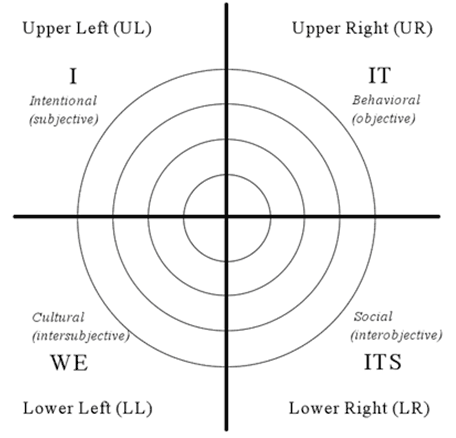 The four dimensions of being, using the human holon as example of the 4 quadrants in this illustration, are the Upper left quadrant (UL); that involves the interior of the person, and the Upper right quadrant (UR); that involves the exterior of the individual, or the unique single physical aspect of the human entity person. The lower left quadrant (LL) is the reality of the collective cultural aspect of the holarchy and its human's cultural interrelations; and lastly, the lower right quadrant (LR) is the aspect of the collective as regards the institutional and social fabric of the holarchy. There are myriad ways to look at this, and Ken Wilber has illustrated various correspondences of aspects of active phenomenal life that can be dissected along the lines of these quadrants Fig 2. 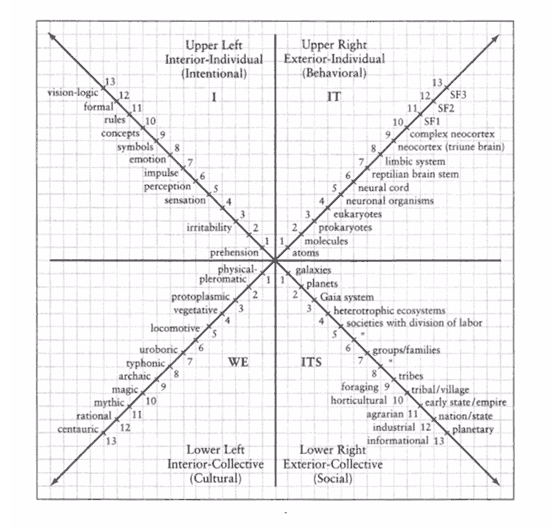 Integral Methodological PluralismWilber has recently updated this 4 Quadrant model to what he calls Integral methodological pluralism (IMP) to add from 4 aspects to 8. This is done by adding to each quadrant another inner dimension, and simultaneously he now creates a correspondence of the now 8 aspects to versions of phenomenal scientific methodologies, as illustrated below Fig 3. In this updated version below we have in the UL quadrant (interior) phenomenology as inside of the interior, and structuralism as the outside of the interior. In the UR quadrant (exterior) we have autopoiesis as the inside of the exterior, and empiricism as the outside of the exterior. In the LL quadrant (intersubjective) we have hermeneutics as the inside of intersubjective, and ethnomethodology, as the outside of the intersubjective; and lastly, we have social autopoiesis as the interior of the interobjective, and systems theory as the exterior of the interobjective. 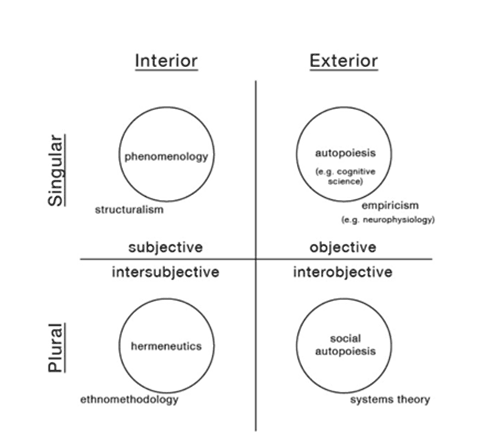 The Lattice modelFigure 4 is the generic lattice that Wilber employs to illustrate the relationship between vertical and horizontal modes of consciousness. Primarily, Wilber uses this lattice to express his notion, that on a vertical stage level of consciousness, as exemplified in the 6 stages going up, an individual at any point in the stage development can have a peak consciousness experience, the horizontal states, of any degree, but will interpret that experience corresponding to the stage level of consciousness they reach. In other words, if one has an experience of a nondual state at the archaic, or mythic stage, they may deduce that they are “Seeing God” because, although the state experience is of a lofty nature, their stage level, being not too lofty, means the person experiencing the state will interpret it subjectively based on their stage level, therefore the interpretation is not an objective fact. Wilber has a more comprehensive graph Fig 5 that is on page 68 Fig 2.4 in his book Integral Spirituality called an “altitude marker.” As one can see, he has extended the stages he calls “levels of consciousness, that he color codes. Wilber's color codes are somewhat strange, or let us call it unique. First, Wilber claims to base this on the chakra sequence that we know has variations—but Wilber completely leaves out the second chakra, which is orange: he says on page 66, in Integral Spirituality “The chakras (Wilber's emphasis) themselves for example start at red, move up to yellow, then green, then blue, then purple, then clear light void…” The clear light crown chakra is new to me, usually it is purple, or in the case of Deepak Chopra's, is Gold. Perhaps Wilber's teachers at the Integral Institute have a unique chakra system, I do not know, but when, and if an educated person like Wilber either makes this kind of error, or changes something as significant as the chakras, well my paranoia gene comes to attention! Anyway, there are other versions of developmental models of human consciousness by various theorists that Wilber throws in and makes correspondences with each other. Though Wilber claims that one cannot make direct correspondences with the stages on the separate lines because their structures are different, and their essences are dealing with different aspects of consciousness. In this essay, we will utilize this version of Wilber's altitude marker as a stepping-stone in which we will attempt from this standpoint to perfect, or complete the AQAL model, figuratively, with revisions. Here it appears Wilber has excelled in presenting his twelve stages of developmental consciousness, despite the odd reference to the chakra sequence, that with additions, will bring the AQAL model into the spiritual realm of metaphysics theoretically, though to do this we must interpret his findings somewhat differently. 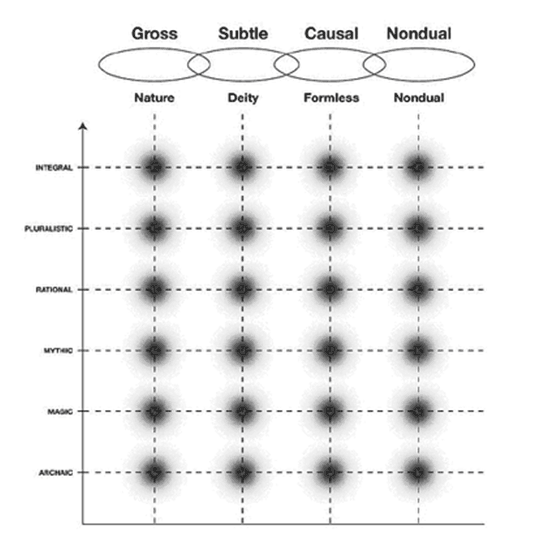 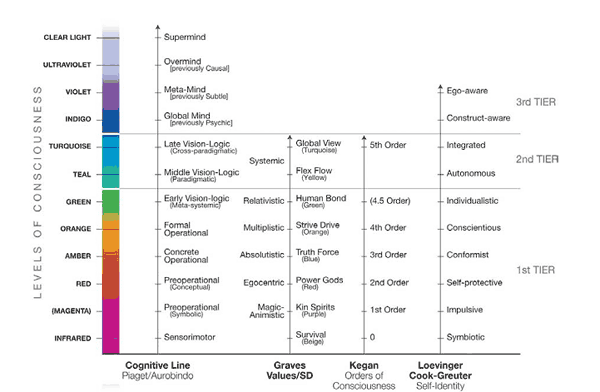 Spiral DynamicsWilber uses this psychological developmental theory based on the work by Professor Clare Graves, then presented to the world by Chris Cowan, and Don Beck in their collaborative effort Spiral Dynamics written in 1996, as an integral part of his map of human existential, and quintessential being. He has somewhat distorted it in the view of many, as in the case of one of its founders, Chris Cowan[1], who has pointed out often that Wilber distorts the theory in Cowan's view. Apparently, Don Beck for a time did not believe Wilber distorted the theory, for he collaborated with him on what they called Spiral Dynamics Integral, an attempt to merge this theory with Wilber's integral philosophy. Although Wilber seems to have broken up this collaboration, nevertheless his romance with spiral dynamics remains, in fact Wilber seems to have, in his eyes, extended it somewhat and obviously has interpreted it in his own light. Spiral Dynamics is a theory of psychological human development only relating to the societal or relational aspects of human thought, and activity. The theory says that people change their outlook about life along a developmental line in the form of a spiral that toggles between value conditions. The value levels are color coded, and separated in a linear tier system:
Supposedly, these second tier colors are modern phenomena having no reality in past eras, thereby indicating the fluent, adoptive, and evolutionary dimensions of human nature. Many theorists don't accept the reality of the second tier. Integral PhilosophySomewhat of a lucid term that denotes a modern new-age idea of synthesizing science and spirituality, in order to produce an objective body of knowledge relating to all aspects of human experience. This has produced active multi movements in this milieu. The Indian mystic Sri Aurobindo is said to have formally began this idea in the early twentieth century with Integral Yoga. Though the movement has roots before Aurobindo, in some traditions of science, mysticism, and religion among primarily European thinkers that stretch back to the 17th century all the way to this era, whom wanted to merge various traditions into a holistic concept of philosophy, science, and spirituality. Ken Wilber's version of Integral philosophy is unique in that he has psycho-spiritual cosmological addenda in AQAL that serves to add a bit of originality and dynamism to his version of integral thinking. I believe this is a good development because he has begun an approach that inspires a deep concentration of the inner dimensions that may evolve into positive developments in psychology, spirituality, and science, MAYBE! Extrapolations of AQAL - IMPThere are major ramifications in Wilber's mind of his discovery of the AQAL-IMP matrix: we will cover some of these, but for space reasons, not all, considering also, that this writing is not a delineation of AQAL, but an attempt to correct its essential points, and complete it, from the writers' perspective. One of these extrapolations has to do with what he calls Kosmic address[2]. (By the way, there are problems with these extrapolations from the writer's perspective that we will cover in-depth in the proceeding section under “Problems with AQAL”) This “Kosmic” address of Wilber has to do with his assertion that phenomena, or “actuality” Wilber's word, can be categorized as an address, which combines the altitude (level of development) and perspective (where the actuality is situated inside the AQAL model) determines the kosmic address. The importance of intersubjectivity is another pet peeve of Wilber. This emphasis is about the various interlocking networks of dynamic conditioning that are existentially influencing the reality of the single sentiment holon, and holarchy, to other holons of an inanimate nature, as well as the huge cultural matrix of ideas, on all levels. These intersubjective networks intend for the entities, and actualities they operate on, a level of pre-destiny of experience and being: We all are destined to be locked into what these networks infer on us, involuntarily. Wilber extrapolates from AQAL that enlightenment “is the realization of oneness with all states and all structures (that evolve over time) that are in existence at any given time. However, on its face from this extrapolation, it appears that Wilber believes evolution molds the spirit rather than the spirit molding evolution. (EVENTHOUGH THE QUESTION ARISES? THAT IT MAY BE THAT THE SPIRIT DOESN'T MOLD EVOLUTION, NOR IS MOLDED BY IT) His belief in this regard also renders enlightenment as just another mental stage not a transcendent state beyond epochal temporality. Of Course, in a higher sense, enlightenment is “normal,” and only transcendent in relationship to the low-consciousness of man's present state. More on this in “Problems with AQAL.” Then we come to Wilber's (what he thinks is his greatest contribution to spirituality) that is his subsuming of what he calls, the wisdom traditions— metaphysics, under the rubric of AQAL and into its evolution or de-evolution in the new era he calls—post-metaphysics. This is obviously something that Wilber is trying to do somewhat slight of hand, while he maintains outward good relations with the modern Guru set whose traditions he claims are obsolete, and require upgrading. Part 2: Problems of AQAL-IMPStates, Stages, and StationsWilber's altitude marker Fig 6: levels and lines of consciousness though workable because of the 12 number of stages (I believe the correct number) is not completely coherent because of his insistence that stages are evolutionary and subject to change, as if these stages are similar to the spiral dynamic based idea of stages being accrued through evolutionary adoption. This idea is incorrect in my view. Wilber in adapting this notion makes this graph incoherent because the stages have no focus. They can go on ad-infinitum. This notion clearly removes AQAL from any metaphysical content, and the way to get over this is to alter the graph, or reinterpret Wilber's “facts.” This can be done by considering the reality that the upper level “stages” he refers to as the third tier, in fact, are not stages at all; they are stations[3], a huge difference. This is not at all a semantic issue, for a stage is a temporary condition of consciousness, whereas a station is a permanent state that completes the cycle, and gives focus to being, and development. Certainly the first nine are legitimately stages, but Wilber probably knows himself, that the higher conditions of his color coded “stages” of clear light, ultraviolet, and violet that he corresponds with Aurobindos, intuitive mind, overmind, and supermind, are states of permanent awareness that are no longer subject to his proverbial evolutionary developmental phenomena. EvolutionIt seems that we must look at this closely and understand the concept of the existential dynamic—CREATION, as it works in developmental phenomena quintessentially, and as it works in the passive systems of reality existentially. This all relates to Wilber's adherence to evolution as existentially spiritually developmental, something it is clearly not in my view.[5] Metaphysicians have always utilized “habits” of nature and turned them for psychological purposes, into “sacred habits” in order to influence and inspire humans to view life as sacred and seek the higher-mind. Modern psychology thoroughly understands this. Therefore, we know that these sacred habits are not sacred at all. Indeed, this can and has been done by mystics with evolution, as it was done when the early metaphysicians told man that family, brother hood was sacred. Now we know better, these things are only natural phenomena, and not any more sacred than any phenomenal reality. What makes evolution any different? He mixes evolution with spiritual modalities, as many new-agers do, e. g Andrew Cohen in suggesting evolution is the thing that determines spiritual growth. By spiritual, we mean of course—metaphysical: brining humans in touch with the divine. Evolution does not drive spiritual growth at all. Spiritual development is driven by cosmic laws that have to do with energy association (development-unity), and energy disassociation (mis-development-separation) Evolution in the other hand is directly relative to creation, and can no more be a natural or an underlying spiritual guide (beyond a symbolic reference) to man as eating can: SURE A HUMAN HAS TO EAT, IN ORDER TO STAY ALIVE, IN ORDER TO KNOW GOD. Is the eating spearheading his knowledge of God therefore? He looks at evolution as an absolute, an error according to metaphysics—it is merely a peripheral phenomenon. Indeed, it is not an absolute despite Buddha's recorded, and very misinterpreted statement, about “change being the nature of this world,” The key here is that he was referring to this world, not all worlds! Any spiritual or metaphysical relationship with evolution is accidental, thus to ascribe a spiritual content to it, is sort of like saying: the devil is spiritual, though mystically this is, as Mansur Hallaj[6] pointed out, somewhat true, it nonetheless misses the point in that metaphysics is about getting above and beyond phenomena, to the unconditioned divine. Wilber's understanding of evolution as it relates to kosmic spiritual reality, I believe, needs to be re-thought. The 4 Quadrants and 8 perspectivesOn the 4 quadrant model, looking closely at it one sees that it is a combination of two metaphysical concepts Fig 6. Vertically, the UL and UR quadrants vs. the LL and LR quadrants we have in describing the individual versus the collective, somewhat of a version of the classical designation of the Hermetic and Taoist idea of microcosm, and macrocosm. Horizontally, in the UL and LL quadrants vs. the UR and the LR quadrants we have the mystical concept of the inward and the outward. These dynamic concepts brought together produce interesting things. It will only be said here that this is most likely the reason for the vagueness and scatteredness (and sometimes difficulty in comprehending) in the 4-quadrant AQAL concept: that is, two different conceptual frameworks (although somewhat related) juxtaposed creates a strange dynamic in the mind of the onlooker. The two intersecting concepts of inward / outward, and micro / macro cause the mind to fragment, thereby stilling the thinker. As relating to the physical structure of the 4-quadrants Wilber has laid the groundwork for understanding the process of horizontal states of mind in the lattice, but I think the world levels (Spirit-Soul-Mind-Body) should be added to this, as the vertical aspect, and to understand the relationship with the horizontal (Nondual-Casual-Subtle-Gross) states and their relationship with each other, and general spiritual and physic development. Moreover, this addition is likely more genuinely relative to Wilber's 8 perspectives that his relating then (the 8 perspectives) to scientific modalities, as we shall see. Wilber's literal expression and understanding of his basic 4 Quadrant model in my view is problematic, and most likely ultimately unworkable. This is so because a quadrant in itself has no substantial reality other than in terms of a geometric reference. In a philosophical sense, the model is only as I said above, a clever intersecting of well-known ideas. The Achilles heel is the LL and LR quadrants that do not comprehensively map reality to any degree of accuracy without tapping into the higher more complex notions of spiritual-energy grids, that go beyond the 4-quadrants and are inclusive of more fundamental realities. There one can remove, or put in perspective, the chafe of any LL or LR elements that as of now only cause undue complexity. However, in some references the model is workable, though in my view, only within the well-defined parameters of the micro and macro, and inward and outward elements of the 4 quadrant conceptual model. Beyond that, I think the model is theoretically untenable, as it stands now. My attempt to re-define( underneath) intimately what a quadrant is, and what the 8 perspectives actually are, I believe is more workable. A quadrant is a quarter of knowledge, or one face of the 4-sided geometrical pyramid, that represents a part of a whole. A quadrant is a part, a perspective is a space. A person never really abides in a quadrant or a space independently because they really abide in the entire range of themselves, and perceive reality in that comprehensive space, not from a perspective or quadrant. A quadrant is literally a broad designation of a quarter of a world, or state space that numbers four intrinsic aspects of the space. One cannot break up the four worlds, or the four states into one or two or three. Take four or none. In other words, a quadrant is either a state as in one of the gross-subtle-casual-nondual states, or a world as in body-mind-soul-spirit-worlds. A perspective is only the way one of these quadrants reflect reality. As for who is viewing the object in the quadrant hypothetically speaking, it is clear that one cant view the object from the same quadrant the object is in, because things can ONLY be viewed in a single quadrant by the viewer existing in all quadrants! This is so because to view even a physical object—that is in the physical world, a body, for instance, one has to view this from the higher realm of the mind. Even to view a mind or interior one has to have ALL the quadrant spaces occupied by the viewer. To break-up this viewing is theoretically untenable. This refutes Wilber's notion of perspectives being paramount, simply because it is impossible to actually being inside a quadrant independent of the other quadrants. We can only occupy ALL of the quadrants. Consequent to this, Wilber's notion that perspective overrides perception doesn't seem to work. For instance, just because humans do not perceive their spirit and soul does not mean their spirit and soul do not exist—it is that their perception is faulty. It is not that we are confined in the limited perspectives of mind and body; on the contrary, it is that we are ONLY looking at our mind and body because that is all we perceive. A perspective in this sense is only the difference between a linear level that is quintessential to a whole, and a parallel level that is existential to the whole. We live quintessentially in the 4-worlds' of spirit-soul-mind-body, but existentially in gross-subtle-casual-nondual. It is a generic term informing that the whole has four parts. The 8 perspectives are informing us that there are fundamentally four basic vertical world-spaces in the holon, and four basic horizontal states of consciousness:
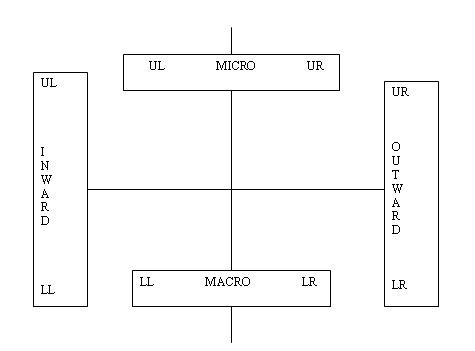 EnlightenmentComing to Wilber's theory of enlightenment that involves it being based on a scale that is related to evolution, therefore, enlightenment is not transcendent. This notion in my view is hard to justify. However, this strange notion may be understood in the light of the fact that spiritual masters have reminded us that there are teachers whom have the capacity to teach anyone, and those who can only teach in their particular school of thought. Unfortunately, this may not completely justify Wilber's idea. It does offer the explanation that he does have half the insight in order, but is misunderstood by him. Thus, I think Wilber needs to rethink this assertion about enlightenment. He is most likely trying to remain consistent with his facts, by asserting that enlightenment is “being one with all lines states, and levels that exist in any era.” This is true according to Wilber's subjective facts, but what if his “facts” are faulty. therefore, lead to faulty conclusions. One faulty fact, as mentioned above, is his mingling of stations with stages. Separating consciousness levels in tiers do not solve the problem because they do not emphasize the huge difference in stages of consciousness and stations. The difference approaches the difference in the Atlantic ocean and the average backyard muddy pond. Wilber's ideas of enlightenment being one with all of AQAL elements is refuted by the singular notion: it is not imperative for the adept to be completely at one with these inner realities, but suffice it that they are at least at peace with them, peace with them enough so they can move on to higher consciousness. The conflicts that these energetic lines and levels exert on the organism, potential and real, has always been known in mystical science, and all kinds of methodologies are utilized to ameliorate the disturbance in the mind of the seeker that these energies can exert (under certain circumstances) in order to move beyond them. Did not our great metaphysical teacher Jesus say: “Give unto Caesar what is Caesar's, and give unto God what is God's.” The unwritten punch line is (if I may be excused for adding to the Masters prose) “Then we can move on to the truth.” Spiral Dynamics, lines, and levelsWilber's use or misuse according to some, of spiral dynamics is another problem with AQAL. Eventhough spiral dynamic theory claims an insight into the microcosm—there is no research of this science relating to AQAL'S UL quadrant relative to monological consciousness, and that seems to be its flaw, in terms of metaphysical or spiritual development. Wilber has championed this (relating the spiral dynamic memes to spirituality (probably with the acceptance of Don Beck.) Mr. Cowan on the other hand has castigated Wilber on occasion, on how he uses it. Though the theory has great merit, it lacks mystical content because of its narrow focus on development along the lines of the LL, and LR quadrants. Clare Graves, and his disciples, if you may, Chris Cowan, and Don Beck have not, (because they are modern social scientist not mystical philosophers) even pretended that the theory covers these areas. In short, this theory understands the microcosm as it relates to the macrocosm, but has little understanding of the microcosm, as it relates to itself, or spirituality. Indeed, NO-ONE (not even Wilber) as of yet has taken the SD memes and broken them down or translated them into a legitimate inner science of the microcosmic struggle as it relates to metaphysics, and spirituality. Therefore Wilber's usurpation of them and juxtaposing them directly into the spiritual developmental line is very unjustified. Legitimate metaphysical spiritual lines of development such as the Sufi 7 men, and the yoga chakra system that reflect this inner microcosm Wilber has thrown to the wayside. Why he does this, is anyone's guess, but at least he should select a legitimate system, or create a legitimate one of his own. The present one he concocts from the altered version of SD memes and his version of the chakras in my view are premature and only experimental at best. Wilber's, I wont say obsession, but I will say over interest in lines, and levels of consciousness makes Wilber a decent philosopher, but a somewhat challenged metaphysician in that he looses focus in the over concentration of these phenomena. The primary focus of the mystic is in his own microcosm, not because he is selfish and only desires the need to free oneself, but because they have, an insight into the fact that as a fragmented human their input in the sea of human development and upliftement is much better served if their own consciousness awareness is perfected. Indeed, this insight informs him or her that more harm (potentially) can be done meddling in the affairs of the world to save it in their present condition of mind, if not vigilant. SummaryFinally, in terms of Wilber's insight concerning AQAL, in my analysis it has to do with the level of human endeavor that relates to the study of the social holon. This knowledge is terrestrial, in that it is a temporary knowledge, since the “evolution” of the human sentiment holon is clearly spread out before us as a microcosm not a macrocosm or entirely a social being. In other words humans are destined to be individuals, I believe, not part of a social holarchy. Though the concept that Wilber popularizes is nonetheless very valid in that we have extreme challenges along these lines of social cooperation that AQAL could, if viewed properly, make great contributions to social betterment. To end this part I would offer somewhat of a friendly warning to the evolutionists, and AQAL acolytes: The overemphasis on evolution and the human as a social holon may lead to an imbalance of understanding and mislead many about their genuine inner nature, and the destiny of humanity. Wilber can over-extrapolate his AQAL theory ad-infinitum, but not without a cost in the end, a large cost to those devoid of critical thinking, and not understand that divinity is ultimately, an equal opportunity employer! The idea of making as many as possible aware of the advantages of an Integral understanding of life, and application of AQAL, is a positive approach. Though as I mentioned in two essays, this should not be mixed with the science of metaphysics in my view, because AQAL as of yet is not aligned with metaphysics because of its terrestrial aspect, and most likely never will be unless or until it can evolve a genuine spiritual dynamic of the microcosm outside of the LL and LR quadrants. As it stands now Wilber seems so much locked into merging one LL thing with another LL thing, almost as a dogmatic pursuit of his version of Integral, rather than a smooth flowing evolution to a mature understanding that could potentially lead to a genuine spiritual insight above the social holonic milieu that AQAL seems stuck in like quicksand. AQAL indeed is only at best a map, and one that involves on close analysis, not even a map of the microcosm but at best a map of social communication or agency as Wilber might say, particularly as it relates to the 4 quadrants, and a philosophical insight into the unity of the UL and LL quadrants inner reality. This is a great leap forward in itself, and has all kinds of positive ramifications independent of Wilber's other ambitious interests in unifying understanding to reach an Einstienian “theory of everything” something even our great scientist gave up on after his cosmological constant went the way of the solid-state theory, and the Edsal. This is a good analogy for the Wilber dilemma, I think. That is the situation of Einstein after coming up with the theory of the century in relativity, and somehow becoming a stalwart of stagnation in supporting his unsupportable cosmological constant, and being against the new idea of the big bang, that just didn't seem eloquent enough for Einstein. Will Wilber go after the mirage of an Integral “theory of everything” through AQAL-IMP, as Einstein went after the mirage of the cosmological constant? Therefore, miss pursuing the essence of his contribution, which in my view is, he spearheading the aspects of Integral consciousness that integrates human thought on a social and moral level, not scientific, spiritual, or clinical level. These levels need much more work to be validated as useful through AQAL-IMP or integral science in my view. Uniting a great part of the world behind the idea of integral tolerance, understanding, and ethics just may be the crown jewel of integral philosophy and methodology, overlooked by our great philosophers of today who all seem running after the mirage of theories of everything that in the end seem to produce very little of nothing. When I first came upon the theories of Ken Wilber I was impressed enough to take it upon myself to study them. When I got what I felt was a fundamental understanding of the AQAL map I surmised it was a genuine insight into a level of reality. I tried all kinds of ways to refute the model but finally thought that Ken Wilber's theory was legitimate in spirit (in other words his essential insight is legitimate) but missing something, or a couple of things maybe. This last part of this essay will attempt to flesh out and add to his theory, on one level. For even this, structural theoretical hypothesis needs work, as the following explanation of the complete model unfolds underneath will illustrate. This will be done in a simple short demonstration that will illustrate interesting connections between an age-old structure steeped in mystical lore, with the modern ideas of Ken Wilber; that structure is the pyramid. Part 3 - AQAL RevisedFirst, is the reconstruction of the lines, and levels Fig 8. The lines of normal bio-psychological being I call the inherent lines of development. These are inherent because they relate to the organism as the natural holon as created, without the burden of the fall from the natural state of perfection, that has precipitated the need for metaphysics, and religious matrixes. These developmental lines are represented in the diagonal lines numbered 3 for physical, 6—mental, 9—moral, and 12 for spiritual. These are purely the developmental lines of the basic organism of the human holon that all people have and develop under all conditions. 3—Physical: represents the three phases of infancy-childhood, adolescence-puberty, and adulthood, as 3 fundamental linear phases of all humans. 6—Mental: Represents the mental developmental line capacity relating to fundamental mental attributes. 9—Moral: The genuine stages having to do with values of the heart—SPIRAL DYNAMIC TYPE CODES APPLY HERE. 12—Spiritual is the natural line of the holistic beings inner healthy development before the intrusion of the corruption-syndrome of the “Fall of man.” This fall called for the artificial temporary lines to the right that are copies of this line, that includes Wilber's line, and one of mine created from my version of the Sufi line of development called the seven men. Within all these lines are included the actual energies and intelligences that Wilber includes in his altitude marker that the developementalist have theorized about and depict in models of human existential and quintessential development and being. (Of course, while we do know that these developmental apparatuses do exist in some form, human knowledge in the psychological realm is as of now as much art as real science. These are all subjective ideas, though very erudite, nonetheless have varying degrees of scientific accuracy. Therefore, we are not sure whether Wilber's developementalist depict exactly how these lines and levels truly operate.) In addition, existing between the lines is what I call “wave lines” that are depicted in FIG 9. These waves are vitally significant. They exist as a conditioning apparatus that interpret, and reflect the experiential matrix of the individual that causes “gravity” of influence in the lines that affect the developmental experience, and life. For example, the condition of the wave - line between the physical and mental lines is the result of the holons experience in life. This wave line should have a heating capacity: neutral—heated—overheated, that determines the degree this wave-line will negatively, neutrally, or positively affect the organism's navigation through life, and inner developmental existence. As they either overheat the developmental lines (as for example, being abused as a child) -- thereby causing a negative affect, or heating it in a positive sense (as being reared with great love)—that may cause a positively exceptional development cycle, or have a neutral gravity towards them, thereby allowing for an ordinary healthy development. There are two sets of basic consciousness levels: one, the traditional dealing with the four horizontal states of gross -- subtle -- casual -- nondual that are multiplied by four reaching 16 sub-states and separated symmetrically as four phase state-levels that all humans access consciously and unconsciously—existentially they constantly toggle between these states. The direct vertical correspondence with these states is the world levels of the fundamental body- mind- soul- spirit that all humans have—quintessentially. They also are separated in sub-worlds equaling 16. However, like the nondual and casual states, most humans have little cognition of the two higher worlds of soul and spirit. These, like the inherent lines mentioned above are inherent to the holonic organism. The next lines and levels, the farthest to the right, in Fig 8, represent the non - inherent temporary levels of spiritual or metaphysical development that are temporarily created similes of the diagonal 12—spiritual line. They are real in the sense that they are symbolic of that 12—diagonal-natural line with the added corruptions to deal with—that man accrued to his soul by the fall that involved him regaining first, his human-hood before moving on to the re-acquisition of spiritual perfection. Wilberian AQAL may reject this as myth of the given metaphysics; nonetheless, these lines are clearly unnatural in the sense that they are related to the negative energy the holon accumulated in the trauma of the fall from primordial grace, or perfection. These lines in my scheme include Wilber's, and my own, added far to the right as a correspondence to his. The difference here is in how I arrange the higher STATIONS--not stages, as I alter Wilber's to include this important subtlety of differentiation of the stages, and stations of consciousness. There is little connection, in reality, between the higher stages of consciousness that are subject to change, and the lofty stations that are no longer subject to change. (As one perfect master once said: one cannot reach the gazelle by running after it, but the only way to reach it is to run after it!) Therefore, to have a literal linear relationship of the stages with the stations doesn't make much sense, because although they do offer somewhat of a guideline in this spiritual path, the fact is no one is guaranteed automatic entrance into the station level because they reach the 9th stage of development. In fact, these stations, for example, Aurobindo's overmind, supermind, and my active-sage, completed human, and Wilber's clear light, and ultraviolet correspond to an active sage. The stations Aurobindo's intuitive-illumined, Wilber's violet, and my perfect awakened represent an inactive sage. There is no qualitative difference in these three stations other than the attributive capacity an active sage must acquire in order to be active. To use an analogy in western metaphysical lore: Abraham and Solomon were equal in spirit, only differing in the fact that Solomon was a King, and Abraham was a Shepard. In essence, what brings AQAL out of the limited terrestrial space is the 12— diagonal line in my map, Fig 8, and a re-interpretation of Wilber's line( the separation of stations and stages) to bring it into the line of site theoretically with metaphysics. It seems that Wilber has created this (his) 12-stage levels of consciousness line, Fig 5, out of a combination of spiral dynamic color coded-memes and his understanding of the chakras. The spiral dynamic codes are not directly relative to the spiritual line—microcosm—they are a moral line—akin to my moral—9 line representing humans is relationship with others—macrocosm. Though this being said I think Wilber's line is acceptable (though incomplete, and only experimental). I hasten to add that I think the line I input—the farthest to the right in figure 8, is more in tune with experience than Wilber's. My emphasis on stations( the top 3—Wilber's third tier) something Wilber neglects, and the important distinction between the natural 12—diagonal line, and what I think are figurative lines on Wilber's map, draws a huge distinction in the two. As stands now, Wilber's lacks focus and unity in my view, sans the contributions that I make to alter or shape AQAL to conform to metaphysics. This also adds a more unified system that recognizes the organism's intelligent inner relationship terrestrially, and spiritually. This is not an arbitrary conformity, because even integral AQAL proponents understand that we gain access to the reality of the supreme spirit through the calm awareness of our own inner dimensions of the soul, and spirit, that are neglected, save Wilber's inclusion of Aurobindo's “stages” in his altitude marker. As said above, this is done with little recognition to these lofty stations, in that Wilber doesn't make much of any distinction between the high stations of Aurobindo's cosmic ideas, and Wilber's spiral dynamic and chakra based color-coded stages of consciousness. I therefore separate this metaphysical-spiritual line into 4 tiers, the forth being what I call the “complete” level. The forth tier is not referred at all to as a tier. This represents the huge difference in mere stages, and the uniquely lofty aspect of what the world understands as the enlightened condition. Fig 8 This brings us to the complete formula for AQAL renamed AW-WALLIID Table 1, and graphic depiction Fig 7 below 1 HOLON (Holistic self) 4 QUADRANTS 4 WORLDS
4 STATES 4 TIERS (LEVELS) OF CONSCIOUSNESS –3 STAGES, 1-COMPLETE STATION 16 HORIZONTAL STATE LEVELS 16 VERTICAL STAGE LEVELS 12 SPIRITUAL STAGES—STATIONS (9-STAGES, AND 3 STATIONS OR 9-1 AS 3=1) 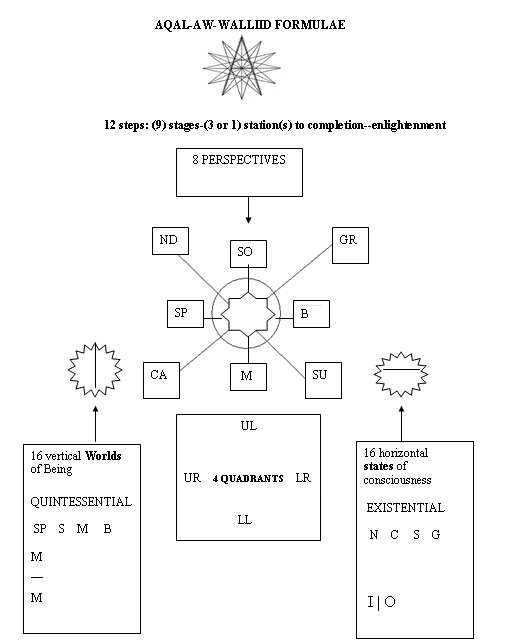
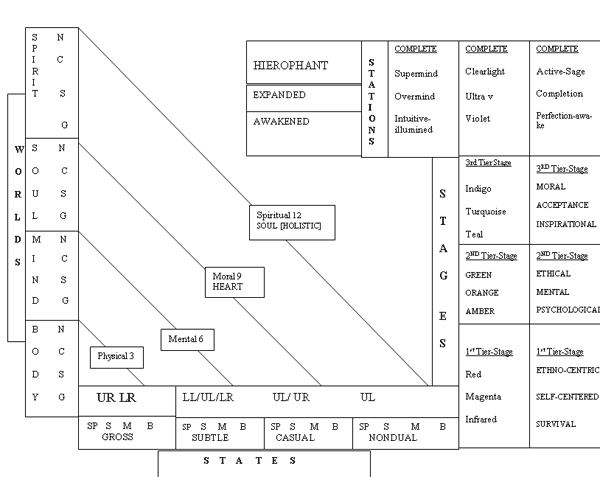 of the worlds, states, stages, and stations of the bio-psycho-spiritual lines and levels of development. 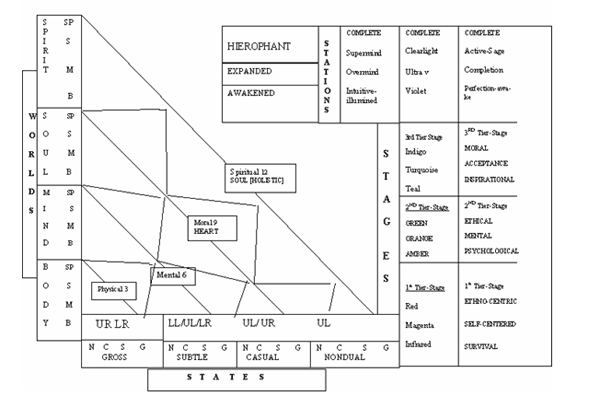 These lines represent the conditioning of experience that exist in all humans that exerts a positive, neutral, or negative influence on the developmental lines and the life of the holon.
ConclusionAW-WALLIID Pronounced (AW sounds like first part of awake-AW and WALL like wall, and LIID sounds like lead) AW-WALLEAD. This stands for: All worlds - Whole, all levels, lines, Intelligences, and Infinite dimensions. AW-WALLIID is in a sense a child of AQAL, in that it is a progression of Wilber's interpretation. The differences are in that I attempt to make the map in theory relative to metaphysics, and spiritual cosmology, from the perspective of bio-psychological development. I hope these small but significant additions at least theoretically bring us somewhat to the spirit, or more precisely the entire map of the holistic human, that includes the mysterious realms of the higher nature of the self. In other words, neither AQAL nor AW-WALLIID maps the whole realm of the entire inner being—which would include soul and spirit. They are maps of the body-mind matrix, with allusions to the higher spiritual. Wilber makes reference to the spiritual realm in his AQAL map but in my view almost as an afterthought, not a heart felt insight into the reality of the two seas of the body-mind realm, and the soul-spirit self, and how and where they meet in the holistic human. Perhaps it is Wilber's Buddhist heritage, the idea of the non-self that originates in certain Buddhist cosmologies, that renders him somewhat gun shy- no pun intended- in his limited elucidation of the higher state of enlightenment in AQAL. Also, it may be that Wilber is trying to mold his facts in a consistent whole [a syndrome I analogize to carving puzzle pieces up to fit in a slot, without regard to what is being made of the whole puzzle]. Or this may be a bone thrown to the scientist whom we all know that Wilber wants to bring into the tent of the spirit. Whatever the case, it seems reasonable from this vantage point to exclude, at this time, the complete elucidation of the soul and spirit realm in this discussion. Indeed, it seems wise to avoid this since there are as many major differences of opinion in that milieu as there are in this environment of TOE thoughts on the developmental body-mind state that would render this discussion extensively complex, something we could surly do without at this time. That said, it is nonetheless useful to slowly bring in these aspects, for when we do finally get a firm hold on the vagaries of the mind and body and their interconnection, then the process of moving on to the spirit may be much simpler, hopefully. I think AW-WALLIID conceptually can assist in this process. It does not like AQAL; require the human to be 100 percent in-tune with the lines and levels, just at peace with them. It recognizes that humans are maximally, as stated in religious ontology's, in a state of fall, and only a shell of his/her original condition. Minimally, those who would label this “myth of the given” metaphysics, will at least concede that man has major developmental problems that metaphysics may be able to ameliorate. Though this concession is as far as I will go, for unlike Wilber, I see very little use in attempting to merge science and religion at this time. For to me, the fissure is just too broad and the divisions are too fundamental, for any real success in this regard to take place. The integral dream of merging these polarities of thought will just have to wait for a clear indication from reality that it is time to merge the two seas into one, and move on to the certainty of holistic understanding. Concerning Wilber's fundamental concentration on the 4 quadrants and the 8 perspectives: It appears that perspectives are difficult, or next to impossible, whence to view anything objectively from, let alone be inside of, exclusively. This is so because of the constant flowing movement of consciousness, as well as the subjective nature of intellectual pursuits for truth. For example, if one tries to view ones self from Wilber's zone #1—the inside of an inside-- they can view all they want, but will not come up with objective truth necessarily, for at best they are viewing from the imagination, an immediate hindrance. Also, few will be able to get beyond the conditioning of the heart—Wilber's perspectives. Indeed, ironically his perspectives are a veil to seeing truth, not a useful vehicle to apprehending facts. That is why mystics understand that one must get beyond imaginings, which are only a mirror of reality (it is this mirror that the science of metaphysics attempts to polish, so reality can be seen clearly) in order that they can be free from Wilber's interlocking networks, and far beyond his “perspectives” thereby able to view reality from the standpoint of unbounded awareness, and clarity. Then one will see clearly that there is only one perspective, and that is the perspective of truth; which is not subject to relativity, because it is absolute being( being the truth) and non-being( seeing the truth ) unmovable, unmoving, without origin, and free of all phenomena. Finally, I must input here, that this essay is an attempt to advance the concentration on the interior subtle structures for the sake of the well-being of humans through knowledge of self. I am not a scholar, nor interested in analyzing Wilberian philosophy for the sake of polemics. Wilber's contributions, in terms of philosophy in my view, have to do with his legitimate insights into the interior of the self, and the inspiration he provides by prompting others to peek into this environment. In the greater scheme of things the differences of opinion are only a form of collective meditation, and contemplative discourse (beyond personalities) of the organic collective coming to grips with itself, and groping for the light, or groping to see the object that the light shines on, that when seen clearly by the individual and or the collective, will enhance the well being of all. NOTES[1] http://www.spiraldynamics.org/learning/response_to_wilber.htm [2] Integral Spirituality pages 69, 251, and 253. [3] The station of No Station Open Secrets of the Sufis—Henry Bayman page 141 [4] Buddhism: The illustrated guide, Pg 69 [5] Integral Spirituality, Appendix II: Post metaphysics. Also pages 94, and 95 [6] The Tawasin, Mansur AL Hallaj
|
||||||||||||||||||||||||||||